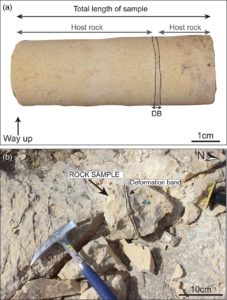Do deformation bands matter for flow? Insights from permeability measurements and flow simulations in porous carbonate rocks
By Atle Rotevatn, Heidi S. Fossmark, Eivind Bastesen, Elin Thorsheim, and Anita Torabi
We investi gate the permeability and flow effects of deformation bands in porous granular carbonate rocks in Malta and use results from flow simulations to discuss the practical implications of deformation bands in carbonate and siliciclastic reservoirs rocks in general. Image- and laboratory-based analyses of deformation bands show permeabilities that are 1 – 2 orders of magnitude lower than the adjacent host rocks. Small-scale outcrop-based flow models (1 × 1 m) focus on the effect of deformation band on flow at the scale of individual bands. Two-phase flow simulations (water displacing oil) show that at the local scale a decrease in deformation band permeability led to increasing flow complexity, reduced and irregular waterfront propagation and reduction in sweep efficiency. A reduction in host rock permeability is associated with increased sensitivity to deformation bands. In low-permeable host rocks, a single magnitude-order reduction of deformation band permeability significantly delays flow, whereas in higher-permeable host rocks the effect is less pronounced. Hence, in some cases, deformation bands may represent a significant impediment to flow already when they are only 1 – 2 orders of magnitude less permeable than host rock. Consequently, deformation bands may have greater practical implications than previously thought, particularly in reservoir rocks with moderate to low host rock permeability.
gate the permeability and flow effects of deformation bands in porous granular carbonate rocks in Malta and use results from flow simulations to discuss the practical implications of deformation bands in carbonate and siliciclastic reservoirs rocks in general. Image- and laboratory-based analyses of deformation bands show permeabilities that are 1 – 2 orders of magnitude lower than the adjacent host rocks. Small-scale outcrop-based flow models (1 × 1 m) focus on the effect of deformation band on flow at the scale of individual bands. Two-phase flow simulations (water displacing oil) show that at the local scale a decrease in deformation band permeability led to increasing flow complexity, reduced and irregular waterfront propagation and reduction in sweep efficiency. A reduction in host rock permeability is associated with increased sensitivity to deformation bands. In low-permeable host rocks, a single magnitude-order reduction of deformation band permeability significantly delays flow, whereas in higher-permeable host rocks the effect is less pronounced. Hence, in some cases, deformation bands may represent a significant impediment to flow already when they are only 1 – 2 orders of magnitude less permeable than host rock. Consequently, deformation bands may have greater practical implications than previously thought, particularly in reservoir rocks with moderate to low host rock permeability.
Click here to read the full Open Access paper in the Petroleum Geoscience Journal [http://pg.lyellcollection.org/content/23/1/104.full]
PESGB members can subscribe to Petroleum Geoscience online-only for £25 for 2017, or £45 for print + online
Please contact barbara@pesgb.org.uk if you are interested in subscribing

